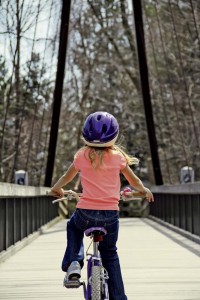The ripple-effect of many decisions can lead to catastrophic results or triumphant success; however, when the tragedy can be avoided with the simple “click” of a safety helmet, making the right choice should be simple.
In fact, that easy choice many take for granted may be what makes the difference between life and death.

According to the Department of Transportation, bicyclists under 14 are at a five times greater risk for injury than older cyclists. Helmets should always be worn for safety.
Though not the only preventative measure, the Department of Transportation states that bicycle helmets are 85 to 88 percent effective in mitigating head and brain injuries, making the use of helmets the single most effective way to reduce head injuries and fatalities resulting from bicycle crashes and other forms of manpowered transportation.
“Helmets play a large part in the safety of our riders during a crash, but the best way to avoid injury is to prevent it from happening,” said Staff Sgt. Joseph Hernandez, 86th Airlift Wing traffic safety manager. “The Air Force helps us out by requiring us to wear a highly visible outer garment, retro-reflective at night, approved bicycle helmet, front white light and rear red reflector or light.”
These rules apply to Airmen at all times and for everyone, including children, operating any type of recreational vehicle on base or while using Ramstein facilities. According to the Department of Transportation, bicyclists ages 14 and under are at five times greater risk for injury than older cyclists.
“We rely on supervisors, security forces and parents to enforce PPE rules,” Hernandez said. “If you see someone breaking a rule, stop, inform and help them.”
Hernandez added that it is everyone’s responsibility to ensure the proper safety precautions are taken.
“Yes, people sometimes have to take risks and do get hurt, but when we assess the risks and prepare, we can avoid taking unnecessary risks and getting hurt needlessly,” Hernandez said. “Is following the rules and using your personal protective gear really worth it? That depends on how much you value your life.”
Note: According to AFI 91-207, all persons who ride a bicycle, tricycle or other human-powered vehicle, including motorized bicycles, on an AF installation in a traffic environment shall wear a properly fastened and approved (e.g., Consumer Product Safety Commission, ANSI, Snell Memorial Foundation or host nation equivalent) bicycle helmet.







